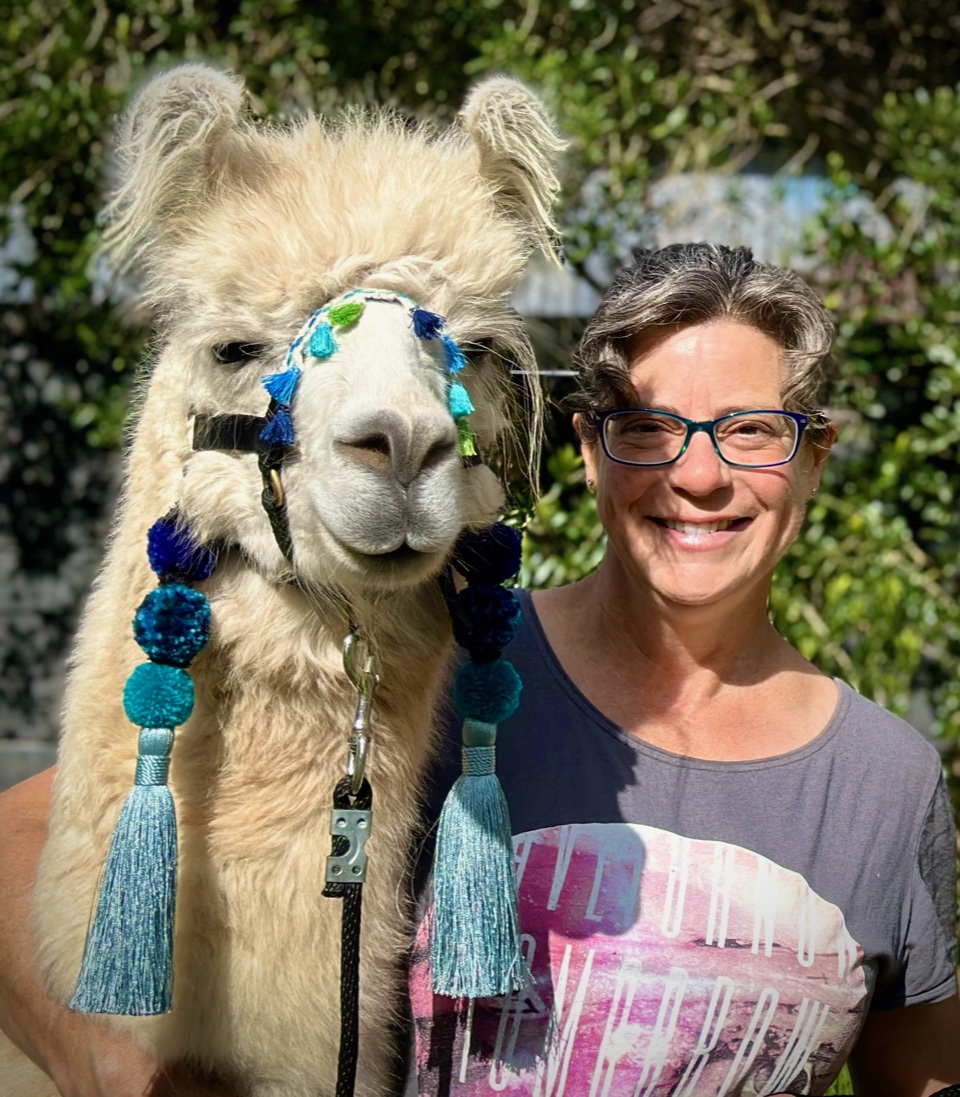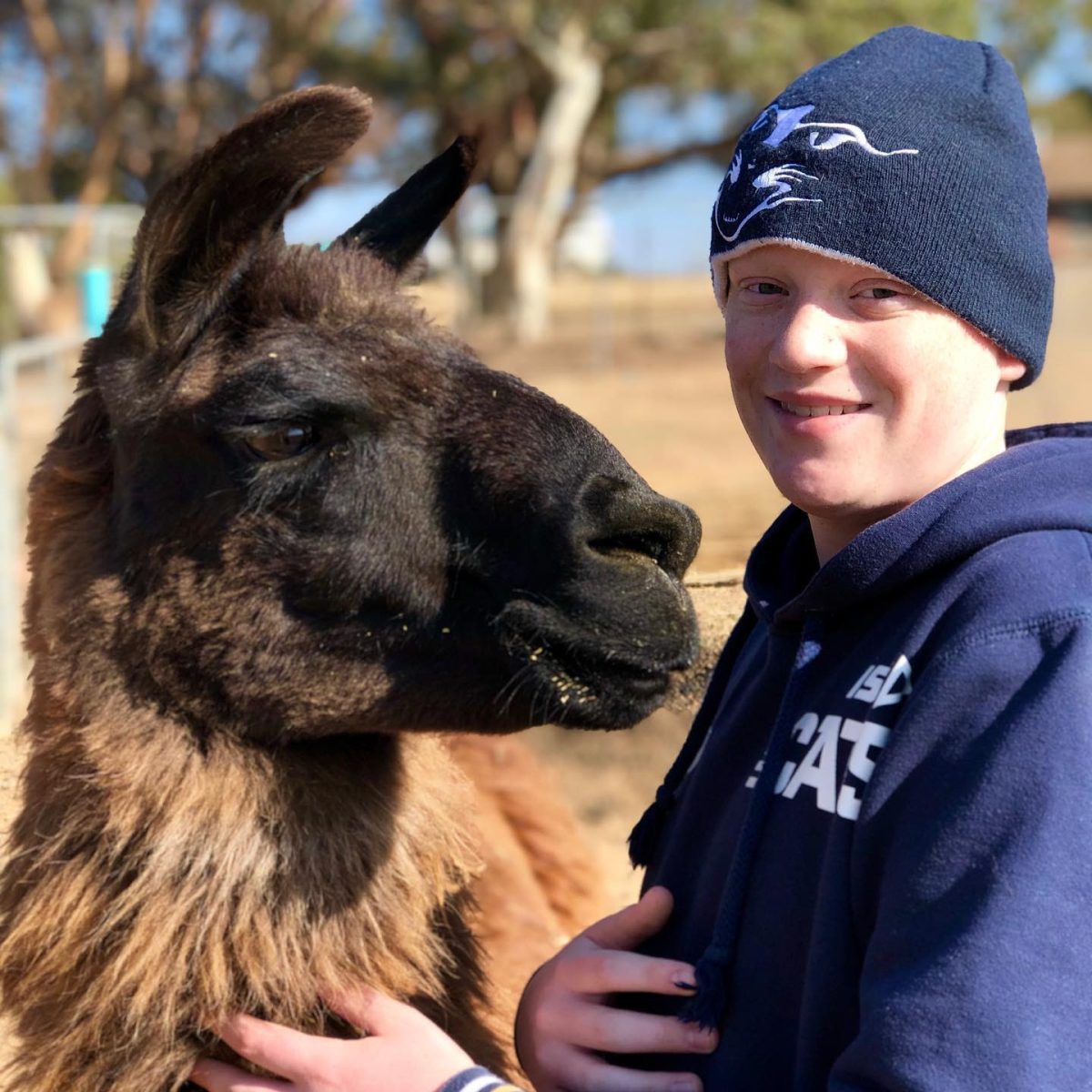
Jane Ackland of Wamboin with Mitch the llama, named after her nephew whom she lost to bone cancer. Photo: Supplied.
When Jane Ackland’s nephew Mitch was diagnosed with osteosarcoma, one of the things that sometimes helped him to forget he was sick were the llamas on her Wamboin farm.
To help ease the stress of constant travel between Canberra and Sydney for treatment, Mitch would work with the llamas, help train them and just get close enough to benefit, according to Jane, from their natural therapeutic qualities.
When Mitch lost his fight with bone cancer at age 16, Jane named one of the llamas after her beloved nephew, but knew there was more she wanted to do.
“After Mitch died, I got PTSD (Post Traumatic Stress Disorder),” Jane said. She ended up leaving her job in the public service.
“After he passed, I spent a lot of hours just sitting in the paddock with my animals … they have always had a very special place in my heart.
“My desire has always been to do the right thing for animals, so after I left the workforce, I needed a new purpose.”
That new purpose, two years in the making, has just come to fruition. Knowing how much being with animals, particularly llamas, helped her nephew and herself through troubled times, she decided to search for the best llamas she could buy for her farm, on the Southern Tablelands of NSW.
“Finding the right llamas became my new purpose,” she said. “The plan was for my partner Neil and I to eventually be able to offer a place for brave sick kids to come out and be with these animals.”
Jane set up Everlong Llamas at Wamboin in 2018. Shortly after, she went to an open day at Alpaca/Llama Magic at Sutton – and came home with two llamas.
“That’ll be it,” she told herself at the time. Today, she has 22 llamas – including five llamas she has just imported from the United States – the first time in about 30 years the animals have been allowed to come here.

Jane Ackland’s nephew Mitch with a llama called Mahogany at Alpaca/Llama Magic at Sutton. Photo: Jane Ackland.
She said the American llamas were chosen for their quality and genetic diversity and underwent rigorous quarantine and blood testing before being allowed into the country.
“I watched online auctions and live broadcasts, checked out every single llama website, spoke to lots of breeders – my ultimate concern was for them to have a safe journey over here.”
She said much of the credit for creating the best environment for the new residents at Wamboin went to her partner Neil Bauer who built all the infrastructure to keep them safe – and comfortable.
To that end, she flew them first-class, in custom-made crates from Chicago to Australia – and they even wore special pyjamas on the flight.
“They were quarantined in Australia for 30 days and because of quarantine they had to be shorn close to the skin. We had to put the shearing off because at the time there was a snowstorm in Chicago – that’s why we had these rugs especially made for them.”
The trip alone cost $55,000 – “it was the most hilarious online shopping spree I’d ever had,” she joked.
Deputy Secretary of Biosecurity and Compliance at the Department of Agriculture, Fisheries and Forestry, Justine Saunders, said the llamas’ arrival heralded an exciting development for Australia’s budding llama population “made possible by our robust animal biosecurity system.

Two of the American llamas aboard the specially made crate check out their surroundings during the flight to Australia from the US. Photo: Supplied.
“Every year we import an array of creatures, ensuring they can safely and sustainably join Australia’s menagerie of wondrous biodiversity,” she said. “All animals are monitored for illness, tested for exotic diseases, and monitored by vets during their stay.”
Jane said North American llamas were taller than their Australian cousins, were very athletic and had beautiful silky fleece – “when they run it looks like they have flying dreadlocks”.
She said there were about 1000 llamas on the Australian registry, but believed there were many more.
“Here, they are used primarily as recreational animals, packing, fibre production, animal therapy, breeding and showing,” she said. “They are very good on our fragile soils as their impact is very light. Alpacas have the best fleece but they are not as engaged with people.
“Llamas are very curious; if we’re doing anything on the farm, they always want to be involved,” she said. “It’s like having a paddock full of friendly dogs.”
Original Article published by Sally Hopman on About Regional.












